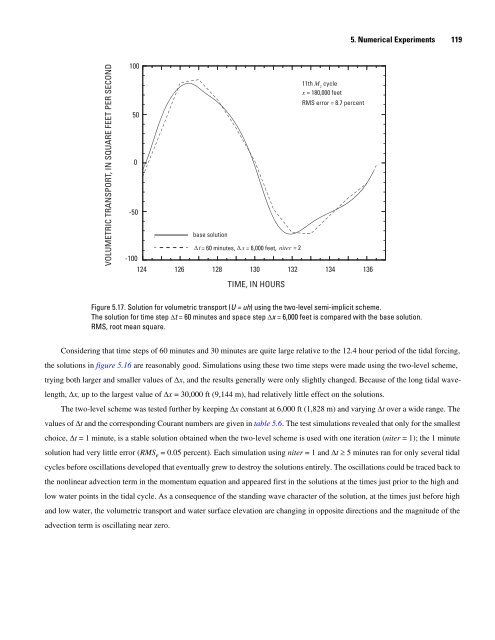A Semi-Implicit, Three-Dimensional Model for Estuarine ... - USGS
A Semi-Implicit, Three-Dimensional Model for Estuarine ... - USGS
A Semi-Implicit, Three-Dimensional Model for Estuarine ... - USGS
Create successful ePaper yourself
Turn your PDF publications into a flip-book with our unique Google optimized e-Paper software.
VOLUMETRIC TRANSPORT, IN SQUARE FEET PER SECOND<br />
100<br />
50<br />
-50<br />
5. Numerical Experiments 119<br />
Considering that time steps of 60 minutes and 30 minutes are quite large relative to the 12.4 hour period of the tidal <strong>for</strong>cing,<br />
the solutions in figure 5.16 are reasonably good. Simulations using these two time steps were made using the two-level scheme,<br />
trying both larger and smaller values of Δx, and the results generally were only slightly changed. Because of the long tidal wave-<br />
length, Δx, up to the largest value of Δx = 30,000 ft (9,144 m), had relatively little effect on the solutions.<br />
The two-level scheme was tested further by keeping Δx constant at 6,000 ft (1,828 m) and varying Δt over a wide range. The<br />
values of Δt and the corresponding Courant numbers are given in table 5.6. The test simulations revealed that only <strong>for</strong> the smallest<br />
choice, Δt = 1 minute, is a stable solution obtained when the two-level scheme is used with one iteration (niter = 1); the 1 minute<br />
solution had very little error (RMS e = 0.05 percent). Each simulation using niter = 1 and Δt ≥ 5 minutes ran <strong>for</strong> only several tidal<br />
cycles be<strong>for</strong>e oscillations developed that eventually grew to destroy the solutions entirely. The oscillations could be traced back to<br />
the nonlinear advection term in the momentum equation and appeared first in the solutions at the times just prior to the high and<br />
low water points in the tidal cycle. As a consequence of the standing wave character of the solution, at the times just be<strong>for</strong>e high<br />
and low water, the volumetric transport and water surface elevation are changing in opposite directions and the magnitude of the<br />
advection term is oscillating near zero.<br />
0<br />
-100<br />
base solution<br />
Δt = 60 minutes, Δx = 6,000 feet, niter = 2<br />
11th M cycle 2<br />
x = 180,000 feet<br />
RMS error = 8.7 percent<br />
124 126 128 130 132 134 136<br />
TIME, IN HOURS<br />
Figure 5.17. Solution <strong>for</strong> volumetric transport (U = uh) using the two-level semi-implicit scheme.<br />
The solution <strong>for</strong> time step Δt = 60 minutes and space step Δx = 6,000 feet is compared with the base solution.<br />
RMS, root mean square.

















